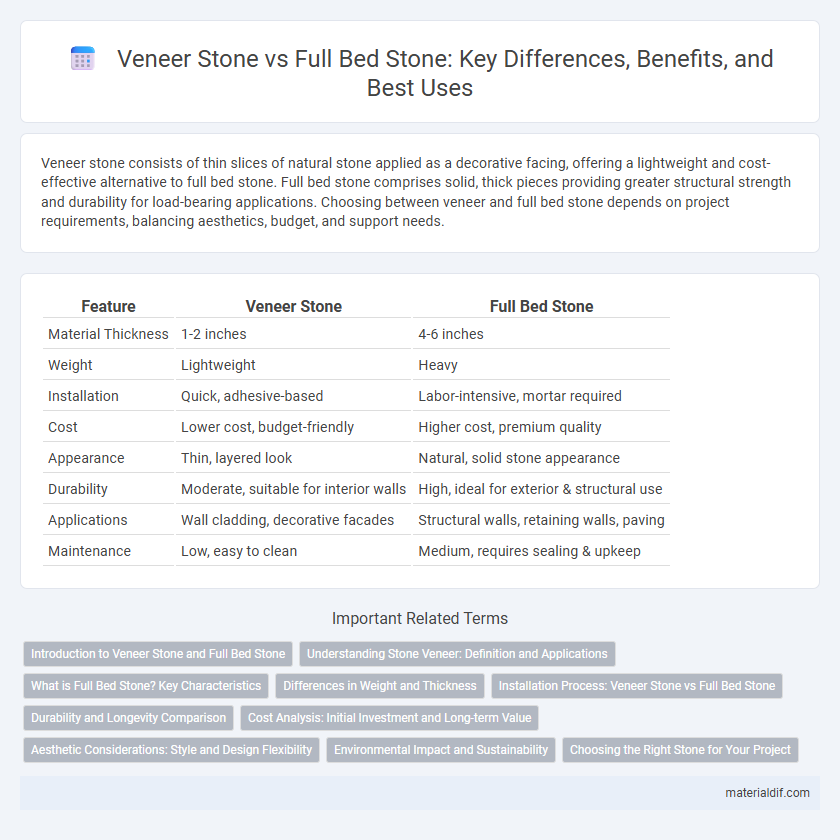Veneer stone consists of thin slices of natural stone applied as a decorative facing, offering a lightweight and cost-effective alternative to full bed stone. Full bed stone comprises solid, thick pieces providing greater structural strength and durability for load-bearing applications. Choosing between veneer and full bed stone depends on project requirements, balancing aesthetics, budget, and support needs.
Table of Comparison
| Feature | Veneer Stone | Full Bed Stone |
|---|---|---|
| Material Thickness | 1-2 inches | 4-6 inches |
| Weight | Lightweight | Heavy |
| Installation | Quick, adhesive-based | Labor-intensive, mortar required |
| Cost | Lower cost, budget-friendly | Higher cost, premium quality |
| Appearance | Thin, layered look | Natural, solid stone appearance |
| Durability | Moderate, suitable for interior walls | High, ideal for exterior & structural use |
| Applications | Wall cladding, decorative facades | Structural walls, retaining walls, paving |
| Maintenance | Low, easy to clean | Medium, requires sealing & upkeep |
Introduction to Veneer Stone and Full Bed Stone
Veneer stone consists of thin, lightweight slices of natural stone applied as a decorative facing, offering aesthetic appeal without the structural weight of full bed stone. Full bed stone refers to solid, thick stone blocks or slabs that provide both structural support and durability, commonly used in load-bearing applications. Choosing between veneer stone and full bed stone depends on factors such as installation requirements, budget, and desired architectural effect.
Understanding Stone Veneer: Definition and Applications
Stone veneer is a thin layer of natural or manufactured stone applied to surfaces for aesthetic appeal and lightweight durability, commonly used in interior and exterior wall cladding, fireplaces, and facades. Unlike full bed stone, which is solid and structurally integral, veneer stone provides the visual texture of stone without the associated weight and cost, making it ideal for renovations and design enhancements. Applications span residential and commercial projects, offering versatility in style while simplifying installation and reducing structural load.
What is Full Bed Stone? Key Characteristics
Full Bed Stone refers to natural stone slabs that are thicker and cut into consistent, full-bodied pieces ideal for structural or load-bearing applications. Key characteristics include their substantial thickness, typically ranging from 1 to 3 inches, uniform slabs for enhanced durability, and high compressive strength making them suitable for both indoor and outdoor construction projects. These stones offer superior longevity and a natural aesthetic compared to thinner veneer stone, which is primarily used for decorative cladding.
Differences in Weight and Thickness
Veneer stone typically weighs less and has a thinner profile, usually between 1/2 to 1 inch thick, making it ideal for lightweight applications and easier installation. Full bed stone is significantly heavier and thicker, often ranging from 2 to 4 inches or more, providing greater structural strength and durability. The weight difference impacts load-bearing capacity, with full bed stone suited for foundational uses while veneer stones serve primarily decorative purposes.
Installation Process: Veneer Stone vs Full Bed Stone
Veneer stone installation involves adhering thin, lightweight stone slices directly onto a prepared substrate, significantly reducing structural support requirements and cutting labor time. Full bed stone requires assembling heavier, full-thickness stones with mortar bed applications and precise leveling, demanding more skilled labor and extended installation periods. The veneer method offers quicker application and cost-efficiency, while full bed stone provides enhanced durability and traditional masonry strength.
Durability and Longevity Comparison
Veneer stone offers a lightweight and cost-effective option but generally has lower durability due to its thin profile and susceptibility to cracking or chipping over time. Full bed stone, composed of solid, natural stone blocks, provides superior longevity and strength, making it ideal for structural applications exposed to harsh weather conditions. The density and thickness of full bed stone ensure enhanced resistance to wear, erosion, and impact, significantly extending its lifespan compared to veneer stone.
Cost Analysis: Initial Investment and Long-term Value
Veneer stone typically demands lower initial investment costs compared to full bed stone due to its thinner, lighter material and easier installation process, reducing labor expenses. Full bed stone, while more expensive upfront, offers superior durability and weather resistance, translating into lower maintenance and replacement costs over time. Analyzing long-term value, full bed stone generally delivers better return on investment through enhanced structural integrity and lifespan, whereas veneer stone suits budget-conscious projects prioritizing aesthetic appeal.
Aesthetic Considerations: Style and Design Flexibility
Veneer stone offers greater design flexibility with its lightweight, thin profile, allowing for diverse installation on walls, fireplaces, and facades without structural reinforcement. Full bed stone provides a timeless, robust aesthetic with natural texture and depth but limits stylistic variation due to its bulkier form. Choosing between veneer and full bed stone hinges on balancing desired visual impact with architectural constraints and design goals.
Environmental Impact and Sustainability
Veneer stone uses less raw material than full bed stone, significantly reducing quarrying impact and preserving natural resources. Its lightweight nature lowers transportation emissions and energy consumption during installation, contributing to a smaller carbon footprint. Full bed stone offers durability but requires more extensive extraction and processing, increasing environmental stress and waste generation.
Choosing the Right Stone for Your Project
Veneer stone offers a lightweight, cost-effective solution ideal for decorative facades, while full bed stone provides superior durability and structural integrity suitable for load-bearing applications. Selecting the right stone depends on the project's requirements, budget, and desired aesthetic, with full bed stone preferred for foundational support and veneer stone favored for exterior cladding or interior accents. Analyzing factors such as installation complexity, maintenance, and environmental exposure ensures optimal performance and longevity.
Veneer Stone vs Full Bed Stone Infographic

 materialdif.com
materialdif.com